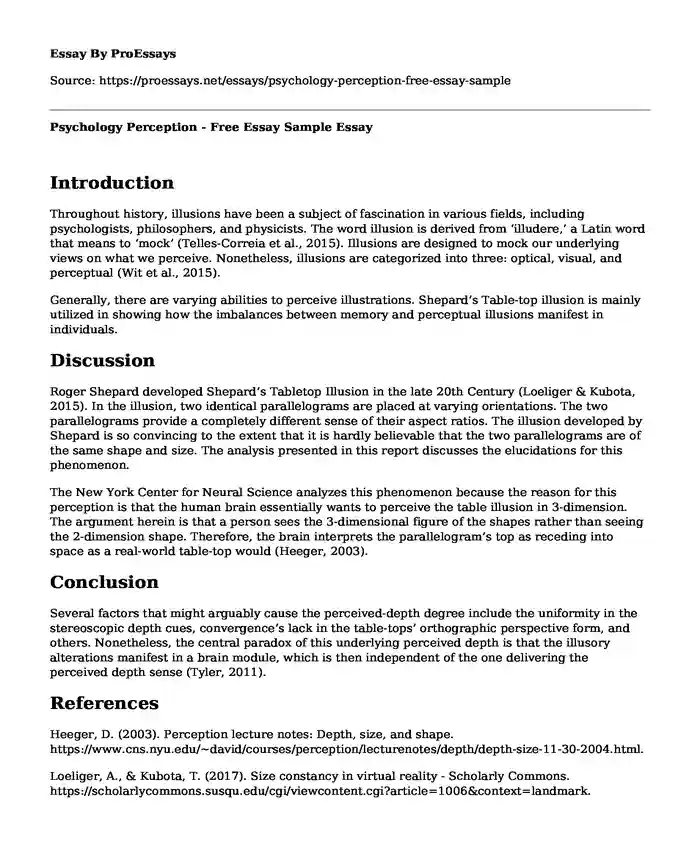Introduction
Throughout history, illusions have been a subject of fascination in various fields, including psychologists, philosophers, and physicists. The word illusion is derived from ‘illudere,’ a Latin word that means to ‘mock’ (Telles-Correia et al., 2015). Illusions are designed to mock our underlying views on what we perceive. Nonetheless, illusions are categorized into three: optical, visual, and perceptual (Wit et al., 2015).
Generally, there are varying abilities to perceive illustrations. Shepard’s Table-top illusion is mainly utilized in showing how the imbalances between memory and perceptual illusions manifest in individuals.
Discussion
Roger Shepard developed Shepard’s Tabletop Illusion in the late 20th Century (Loeliger & Kubota, 2015). In the illusion, two identical parallelograms are placed at varying orientations. The two parallelograms provide a completely different sense of their aspect ratios. The illusion developed by Shepard is so convincing to the extent that it is hardly believable that the two parallelograms are of the same shape and size. The analysis presented in this report discusses the elucidations for this phenomenon.
The New York Center for Neural Science analyzes this phenomenon because the reason for this perception is that the human brain essentially wants to perceive the table illusion in 3-dimension. The argument herein is that a person sees the 3-dimensional figure of the shapes rather than seeing the 2-dimension shape. Therefore, the brain interprets the parallelogram’s top as receding into space as a real-world table-top would (Heeger, 2003).
Conclusion
Several factors that might arguably cause the perceived-depth degree include the uniformity in the stereoscopic depth cues, convergence’s lack in the table-tops’ orthographic perspective form, and others. Nonetheless, the central paradox of this underlying perceived depth is that the illusory alterations manifest in a brain module, which is then independent of the one delivering the perceived depth sense (Tyler, 2011).
References
Heeger, D. (2003). Perception lecture notes: Depth, size, and shape. https://www.cns.nyu.edu/~david/courses/perception/lecturenotes/depth/depth-size-11-30-2004.html.
Loeliger, A., & Kubota, T. (2017). Size constancy in virtual reality - Scholarly Commons. https://scholarlycommons.susqu.edu/cgi/viewcontent.cgi?article=1006&context=landmark.
Telles-Correia, D., Moreira, A. L., & Gonçalves, J. S. (2015). Hallucinations and related concepts—their conceptual background. Frontiers in Psychology, 6.
https://doi.org/10.3389/fpsyg.2015.00991
Tyler, C. W. (2011). Paradoxical perception of surfaces in the shepard tabletop illusion. i-Perception, 2(2), 137–141. https://doi.org/10.1068/i0422
Wit, M. M. D., Kamp, J. V. D., & Withagen, R. (2015). Visual illusions and direct perception: Elaborating on Gibson's insights. New Ideas in Psychology, 36, 1–9.
https://doi.org/10.1016/j.newideapsych.2014.07.001.
Cite this page
Psychology Perception - Free Essay Sample. (2024, Jan 01). Retrieved from https://proessays.net/essays/psychology-perception-free-essay-sample
If you are the original author of this essay and no longer wish to have it published on the ProEssays website, please click below to request its removal:
- Discussion Reply of the Johari Window Paper Example
- Occupational Health and Safety Administration Cites Missouri Plumbing Company - Essay Sample
- Essay Example on Re-Evaluate Goals for Personal Change Success
- Essay Example on Mental Approaches: Reasoning, Understanding & Expectations
- US Vets: Causes, Symptoms & Treatment of PTSD - Research Paper
- The Development of Ego and Id: A Psychoanalytic Perspective - Essay Sample
- Navigating Leadership Challenges: Women's Representation and Emotional Intelligence at Tizer Pharmaceutical Firm







